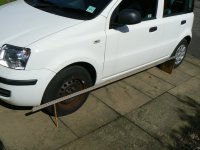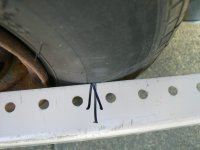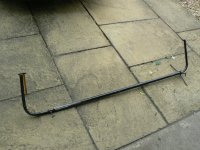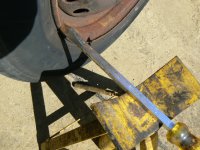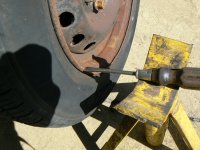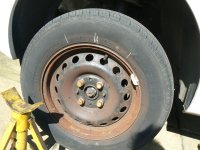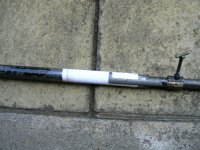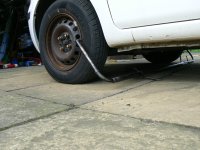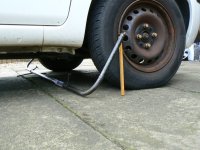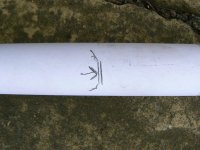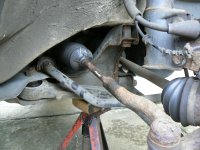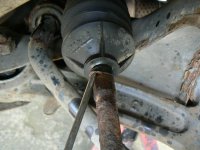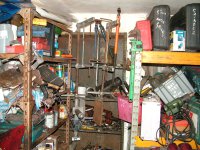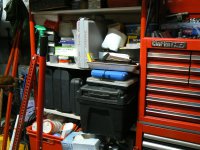Thought I'd post this here because although I'm going to be referring specifically to our Panda, the general principles apply to many vehicles.
So what's the problem? Well, I've noticed that Becky's O/S/F - driver's side front - tyre is wearing slightly more rapidly on it's inner shoulder than over the rest of the tread width. Look here and you can see the inner shoulder (on the left) is wearing more than the rest:

Compare this with the N/S and you can see the difference

Sorry, orientation of the pictures is confusing as the top one was shot from the rear and the one above was taken from in front of the car. In both pictures you're comparing the shoulder on the left of the picture.
So what I'm seeing here is the inner shoulder wearing more quickly on the O/S tyre but the tread wearing evenly on the N/S. This could be due to something bent or worn in the suspension on that side so the first thing to do is carefully and thoroughly check the suspension out on that side. So, Jack the car up and get an axle stand or two in for safety sake. People are often asking where to jack and/or put axle stands. Well, most cars will have reinforced jacking points on the sills but you can also jack or put stands under the subframe or body box sections Here's a picture showing how I've got a stand under the subframe:

But you can also see reinforced box sections - the bits with the holes in - that will happily take the weight of the car.
So, now it's safe and not going to fall on you, grip the wheel at the quarter to three position - one hand on the left and one on the right of the tyre and try to rock the wheel back and forwards. If you pull hard enough you'll be able to turn the steering - although the steering lock may click in if the key isn't in the ignition - but what you're looking for is play and you don't need to turn the steering to feel that. Now grip the wheel again at the six o'clock position - one hand at the top and one at the bottom and again try to rock it. Movement in this plane is more likely to be wheel bearing but you can also pick up on suspension joints.Might be in the bottom ball joint or track rod end:

bottom ball joint is at the left hand end of that arm and the track rod end is a bit above and to the right of the convoluted CV boot. Shouldn't be any free play in them.People tend to forget that there's also a ball joint inside the steering rack dust gaiter. it tends to give itself away by allowing the track arm to jump in and out in a straight line if it's worn:
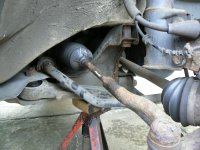
It's inside the convoluted gaiter in the middle of the picture - you can see the track rod end in this picture too at the bottom right.
More difficult to ascertain is whether there's a problem with the rubber bushes on the inner ends of the bottom suspension arms. Here's Becky's:

That one is the rear one. Here's the front one:
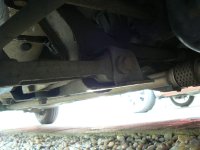
Sorry, not a very good picture of that front one. The problem here is because they are rubber, unless they are absolutely falling to pieces, it's difficult to decide whether they need replacing or not. If you lever them with something like a crowbar or big screwdriver then, of course, they are going to give, they're made of rubber so they will, but how much give is acceptable - and this can be especially difficult to ascertain with void bushes if you're not used to them. (void bushes aren't solid rubber all through so they "give" more in one direction than another)
Quite a "neat" way to check them is, with the weight of the vehicle still on the ground, to put a power bar or similar tool on a wheel nut:

Then push down and pull up on the bar and see if the wheel moves back and forwards in the wheel arch. If it does then something is worn and it may well be a rubber bush, especially if you've already checked out the ball joints. Get a helper to work the power bar while you take a look, it's usually easy enough to see where the play is.
If you're getting movement in any of these parts, there's no point trying to set up the toe in - which is what we're going to be doing. You need to sort out the worn bits by fitting new ones.
Ok, now we know our suspension and steering is sound, and I'll say again, don't waste your time trying to set up toe (or, for that matter, any other steering parameters like castor, camber. KPI etc) but we are only considering Toe here because it's reasonably achievable at home whereas the rest really needs professional equipment. Toe is also by far the most likely thing to be causing unusual tyre wear.
So what is "Toe". Well, quite simply, it's whether the front wheels have their front edges facing in the way - which would be toe in - and would cause the outer edges of the tyres to wear rapidly as well as feathering the tread pattern. Or, outwards, which causes the inner shoulders to wear and feather the rest of the tread in the other direction. Looking at the Haynes Manual for our Panda it tells me the toe setting is "Parallel" so the wheels are intended to roll down the road exactly parallel, neither pointing in towards each other or outwards. You might think that's obvious if you don't want to scrub life out of the tyres but not a bit of it. Many vehicles are set statically with a little bit of either toe in or toe out. This is because when the vehicle is rolling you need to compensate for movement in bushes and slight play in other components. It's not unusual to find a rear wheel drive car carries a little toe in because the front wheels, being undriven, tend to drag and splay outwards, particularly when braking whereas a front wheel drive car will be trying to make it's front wheels "squint" as they drive forward. This is however, not a "golden" rule, I've seen front wheel drive cars specified with toe in - can't remember a rear wheel drive with toe out though. You need to consult the manufacturer's specs.
Well, Becky is very slightly wearing the inside of her O/S/F tyre but not affecting her N/S tyre, strange? well no, not if the toe is set with only very slightly too much "out". If there's only slightly too much toe out then this wear pattern is common. But toe out means the two front wheels are splaying out slightly so that means the N/S is trying to go towards the kerb and the O/S is trying to go towards the white line in the middle of the road? Well yes, and if the degree of toe out is excessive then wear will be seen on the inside of both treads with the pattern feathered over the width of both tyres. However, our roads are cambered towards the kerb for rain runoff. None of us notice this but we subconsciously steer very slightly to the right to counteract this. What this means for those front tyres is that, if there is only a very small amount of excess toe out then the O/S (right hand side) wheel and it's tyre do indeed point slightly towards the middle of the road but but it is stopped from moving the vehicle in that direction by the influence of the camber and grip of the N/S (left hand side) wheel and tyre which are rolling straight ahead. Result? N/S tyre wears evenly but O/s wears on the inner shoulder - exactly what I have on Becky. So I'm expecting to find she has a very small amount of excess toe out. In fact I think that someone has, in the past, adjusted her toe incorrectly because her steering wheel is actually very slightly to the left when going in a straight line.
This thread is getting very long and I don't know if there's a limit. So I'm stopping it here and taking up again in minute down the page.
So what's the problem? Well, I've noticed that Becky's O/S/F - driver's side front - tyre is wearing slightly more rapidly on it's inner shoulder than over the rest of the tread width. Look here and you can see the inner shoulder (on the left) is wearing more than the rest:

Compare this with the N/S and you can see the difference

Sorry, orientation of the pictures is confusing as the top one was shot from the rear and the one above was taken from in front of the car. In both pictures you're comparing the shoulder on the left of the picture.
So what I'm seeing here is the inner shoulder wearing more quickly on the O/S tyre but the tread wearing evenly on the N/S. This could be due to something bent or worn in the suspension on that side so the first thing to do is carefully and thoroughly check the suspension out on that side. So, Jack the car up and get an axle stand or two in for safety sake. People are often asking where to jack and/or put axle stands. Well, most cars will have reinforced jacking points on the sills but you can also jack or put stands under the subframe or body box sections Here's a picture showing how I've got a stand under the subframe:

But you can also see reinforced box sections - the bits with the holes in - that will happily take the weight of the car.
So, now it's safe and not going to fall on you, grip the wheel at the quarter to three position - one hand on the left and one on the right of the tyre and try to rock the wheel back and forwards. If you pull hard enough you'll be able to turn the steering - although the steering lock may click in if the key isn't in the ignition - but what you're looking for is play and you don't need to turn the steering to feel that. Now grip the wheel again at the six o'clock position - one hand at the top and one at the bottom and again try to rock it. Movement in this plane is more likely to be wheel bearing but you can also pick up on suspension joints.Might be in the bottom ball joint or track rod end:
bottom ball joint is at the left hand end of that arm and the track rod end is a bit above and to the right of the convoluted CV boot. Shouldn't be any free play in them.People tend to forget that there's also a ball joint inside the steering rack dust gaiter. it tends to give itself away by allowing the track arm to jump in and out in a straight line if it's worn:

It's inside the convoluted gaiter in the middle of the picture - you can see the track rod end in this picture too at the bottom right.
More difficult to ascertain is whether there's a problem with the rubber bushes on the inner ends of the bottom suspension arms. Here's Becky's:

That one is the rear one. Here's the front one:

Sorry, not a very good picture of that front one. The problem here is because they are rubber, unless they are absolutely falling to pieces, it's difficult to decide whether they need replacing or not. If you lever them with something like a crowbar or big screwdriver then, of course, they are going to give, they're made of rubber so they will, but how much give is acceptable - and this can be especially difficult to ascertain with void bushes if you're not used to them. (void bushes aren't solid rubber all through so they "give" more in one direction than another)
Quite a "neat" way to check them is, with the weight of the vehicle still on the ground, to put a power bar or similar tool on a wheel nut:

Then push down and pull up on the bar and see if the wheel moves back and forwards in the wheel arch. If it does then something is worn and it may well be a rubber bush, especially if you've already checked out the ball joints. Get a helper to work the power bar while you take a look, it's usually easy enough to see where the play is.
If you're getting movement in any of these parts, there's no point trying to set up the toe in - which is what we're going to be doing. You need to sort out the worn bits by fitting new ones.
Ok, now we know our suspension and steering is sound, and I'll say again, don't waste your time trying to set up toe (or, for that matter, any other steering parameters like castor, camber. KPI etc) but we are only considering Toe here because it's reasonably achievable at home whereas the rest really needs professional equipment. Toe is also by far the most likely thing to be causing unusual tyre wear.
So what is "Toe". Well, quite simply, it's whether the front wheels have their front edges facing in the way - which would be toe in - and would cause the outer edges of the tyres to wear rapidly as well as feathering the tread pattern. Or, outwards, which causes the inner shoulders to wear and feather the rest of the tread in the other direction. Looking at the Haynes Manual for our Panda it tells me the toe setting is "Parallel" so the wheels are intended to roll down the road exactly parallel, neither pointing in towards each other or outwards. You might think that's obvious if you don't want to scrub life out of the tyres but not a bit of it. Many vehicles are set statically with a little bit of either toe in or toe out. This is because when the vehicle is rolling you need to compensate for movement in bushes and slight play in other components. It's not unusual to find a rear wheel drive car carries a little toe in because the front wheels, being undriven, tend to drag and splay outwards, particularly when braking whereas a front wheel drive car will be trying to make it's front wheels "squint" as they drive forward. This is however, not a "golden" rule, I've seen front wheel drive cars specified with toe in - can't remember a rear wheel drive with toe out though. You need to consult the manufacturer's specs.
Well, Becky is very slightly wearing the inside of her O/S/F tyre but not affecting her N/S tyre, strange? well no, not if the toe is set with only very slightly too much "out". If there's only slightly too much toe out then this wear pattern is common. But toe out means the two front wheels are splaying out slightly so that means the N/S is trying to go towards the kerb and the O/S is trying to go towards the white line in the middle of the road? Well yes, and if the degree of toe out is excessive then wear will be seen on the inside of both treads with the pattern feathered over the width of both tyres. However, our roads are cambered towards the kerb for rain runoff. None of us notice this but we subconsciously steer very slightly to the right to counteract this. What this means for those front tyres is that, if there is only a very small amount of excess toe out then the O/S (right hand side) wheel and it's tyre do indeed point slightly towards the middle of the road but but it is stopped from moving the vehicle in that direction by the influence of the camber and grip of the N/S (left hand side) wheel and tyre which are rolling straight ahead. Result? N/S tyre wears evenly but O/s wears on the inner shoulder - exactly what I have on Becky. So I'm expecting to find she has a very small amount of excess toe out. In fact I think that someone has, in the past, adjusted her toe incorrectly because her steering wheel is actually very slightly to the left when going in a straight line.
This thread is getting very long and I don't know if there's a limit. So I'm stopping it here and taking up again in minute down the page.
Last edited:



